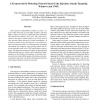158 search results - page 3 / 32 » An Architectural Approach to Preventing Code Injection Attac... |
NDSS
2007
IEEE
13 years 11 months ago
2007
IEEE
Cross-site scripting (XSS) is an attack against web applications in which scripting code is injected into the output of an application that is then sent to a user’s web browser....
SP
2009
IEEE
13 years 11 months ago
2009
IEEE
Providing online access to sensitive data makes web servers lucrative targets for attackers. A compromise of any of the web server’s scripts, applications, or operating system c...
CCS
2008
ACM
13 years 6 months ago
2008
ACM
Harvard architecture CPU design is common in the embedded world. Examples of Harvard-based architecture devices are the Mica family of wireless sensors. Mica motes have limited me...
ACSAC
2005
IEEE
13 years 10 months ago
2005
IEEE
Code injection vulnerabilities continue to prevail. Attacks of this kind such as stack buffer overflows and heap buffer overflows account for roughly half of the vulnerabilities...
ACSAC
2010
IEEE
13 years 1 months ago
2010
IEEE
Heap spraying is an attack technique commonly used in hijacking browsers to download and execute malicious code. In this attack, attackers first fill a large portion of the victim...

